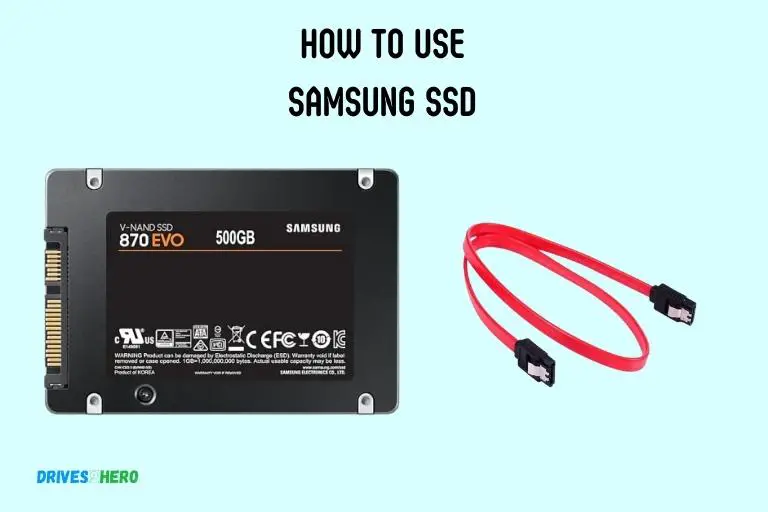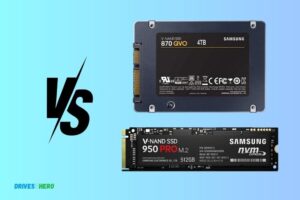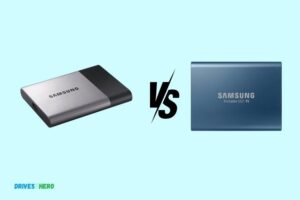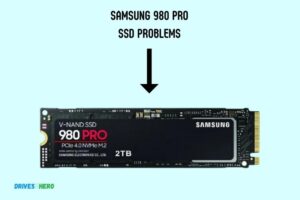How to Use Samsung Ssd? 10 Steps!
To use a Samsung SSD, simply connect the SSD to your device’s SATA or USB port and follow the prompts for installation and setup.
If you’ve just acquired a Samsung SSD and are eager to harness its power, this step-by-step guide will walk you through the simple process of setting up and optimizing your SSD.
By following these steps, you can optimize your Samsung SSD’s performance and ensure smooth operation on your device.

Key Takeaway
Step-by-Step Guide for Using Your Samsung SSD
Step 1: Connect Your Samsung SSD
- Plug one end of the SATA cable into your SSD and the other into the motherboard.
- Connect the power cable from the power supply to your SSD.
Step 2: Mount the SSD
- If it’s a 2.5-inch SSD, secure it in a 3.5-inch drive bay using the provided bracket.
- For M.2 SSDs, insert it into the M.2 slot on the motherboard.
Step 3: Power On Your Computer
- Start your computer and check if the SSD is recognized in the BIOS/UEFI settings.
Step 4: Initialize and Format the SSD
- Right-click the Start button, select “Disk Management” in Windows.
- Locate your SSD, right-click, choose “Initialize Disk,” then format it.
Step 5: Update SSD Firmware (Optional)
- Visit the Samsung website for firmware updates.
- Download and install any available updates.
Step 6: Optimize Windows for SSD
- Disable disk defragmentation and enable TRIM support in Windows settings.
Step 7: Configure Samsung Magician (Optional)
- Install Samsung Magician software (if included).
- Use it to optimize performance and monitor your SSD.
Step 8: Transfer Data to SSD
- Use Samsung Data Migration for cloning or manually transfer files.
- Install a fresh OS if needed.
Step 9: Regular Backups
- Schedule backups to protect your data on the Samsung SSD.
Step 10: Enjoy Improved Performance
- Your Samsung SSD is now set up for faster data access and enhanced overall performance.
Follow these straightforward steps to make the most of your Samsung SSD, improving your computer’s speed and responsiveness.
Configuring And Setting Up Your Samsung Ssd
Discover the step-by-step process for configuring and setting up your Samsung SSD. Learn how to effectively use your Samsung SSD with this easy-to-follow guide.
Formatting The Samsung Ssd For Initial Use
To ensure smooth operation and maximum performance, it’s important to format your Samsung SSD correctly.
Here are the steps to format the SSD:
- Connect the Samsung SSD to your computer using a SATA cable.
- Open the Disk Management tool by right-clicking on the Start menu and selecting “Disk Management”.
- Locate your Samsung SSD in the list of drives and right-click on it.
- Select the “Format” option and choose the desired file system (NTFS is recommended for most users).
- Assign a drive letter to the SSD and click “OK” to start the formatting process.
- Once the formatting is complete, your Samsung SSD is ready for use.
Optimizing The Ssd Settings For Maximum Performance
To get the most out of your Samsung SSD, it’s essential to optimize its settings.
Follow these tips to ensure maximum performance:
- Enable AHCI mode in your computer’s BIOS to leverage the enhanced features of the SSD.
- Install the latest firmware for your Samsung SSD to benefit from any performance improvements or bug fixes.
- Disable disk defragmentation for the SSD, as it can cause unnecessary wear and tear.
- Enable TRIM on your operating system to maintain optimal SSD performance over time.
- Adjust the power settings to prevent the computer from turning off the SSD to save power.
By following these steps, you can configure and set up your Samsung SSD properly, optimizing its performance and avoiding common setup issues.
With a properly configured SSD, you’ll experience faster boot times, quicker file transfers, and an overall smoother computing experience.
Transferring Data To Your Samsung Ssd
Discover the seamless process of transferring data to your Samsung SSD with our step-by-step guide. Learn how to efficiently use your Samsung SSD and optimize your storage experience.
Methods For Transferring Data From Your Old Storage Device:
Transferring your data can be done in various ways, depending on the type of data and your preferences.
Here are a few common methods you can consider:
- External Hard Drive: Connect an external hard drive to your computer and copy the files and folders you wish to transfer onto it. Once done, connect the external hard drive to your new Samsung SSD and copy the data over.
- Data Transfer Software: Some SSD manufacturers provide their own data transfer software that simplifies the process. Check if Samsung offers such software for your SSD model and follow the instructions provided.
- Cloud Storage: If you have a reliable internet connection, you can consider uploading your data to a cloud storage service, such as Google Drive or Dropbox. Once uploaded, you can then download the data onto your new Samsung SSD.
Tips For Ensuring A Smooth Data Transfer Process:
To make sure your data transfer goes smoothly, consider the following tips:
- Organize and Clean Up: Before transferring your data, take the opportunity to organize your files and remove any unnecessary or duplicate files. This will save both time and storage space.
- Check Compatibility: Ensure that your Samsung SSD is compatible with your computer’s operating system and connectors to avoid any compatibility issues.
- Install Latest Firmware: Check for any available firmware updates for your Samsung SSD and install them before starting the data migration process.
- Have Adequate Power: It’s important to have a stable power source throughout the data transfer process. Consider using a UPS (Uninterruptible Power Supply) if possible.
- Patience is Key: Transferring large amounts of data can take time. Avoid interrupting the process and be patient until it’s complete.
By following these methods, step-by-step instructions, and tips, you can smoothly transfer your data to your new Samsung SSD, ensuring a seamless transition and optimal performance.
Troubleshooting Common Issues
We unravel solutions to common issues, empowering you to navigate potential challenges and unlock the full potential of your Samsung SSD experience. Let’s troubleshoot and enhance your SSD utilization effortlessly.
If your Samsung SSD is not recognized by your computer, try these troubleshooting steps:
- Check the physical connections: Ensure that the SSD is properly connected and securely seated in its slot.
- Update the SSD firmware: Visit Samsung’s website and download the latest firmware for your SSD. Install it following the provided instructions.
- Check the BIOS settings: Enter the BIOS and verify that the SSD is enabled. If necessary, change the SATA mode to AHCI or enable the NVMe protocol for M.2 SSDs.
- Test the SSD on another computer: If possible, connect the SSD to a different computer to rule out any hardware compatibility issues.
- My Samsung SSD is running slow. How can I improve its performance?
If your Samsung SSD is running slow, try these tips to improve its performance:
- Ensure that your SSD has sufficient free space: SSDs perform best when they have ample free space. Delete any unnecessary files or applications to create more space.
- Run a disk cleanup: Use the built-in disk cleanup tool in Windows to remove temporary files, recycle bin contents, and other system junk that may be slowing down your SSD.
- Check for malware or viruses: Perform a thorough scan of your computer using an updated antivirus program to eliminate any potential threats that may be impacting your SSD’s performance.
- Disable unnecessary startup programs: Use the Task Manager to identify programs that start automatically with your computer and disable those that are not essential.
Remember, Samsung SSDs are highly reliable and offer impressive performance. If you encounter any issues, following the troubleshooting steps mentioned above should help resolve them.
Conclusion
Using Samsung SSD is a game-changer for your storage needs. Its lightning-fast speed and reliable performance guarantee enhanced productivity and efficiency for both personal and professional use.
Whether you are a gamer, content creator, or business professional, Samsung SSD provides the optimal solution for storing and accessing your data with utmost ease.
With its advanced features like rapid read and write speeds, improved load times, and durable design, you can expect a seamless experience in managing your files and applications.
Samsung’s commitment to innovation ensures that their SSDs continue to evolve and meet the demands of the ever-changing digital landscape.






